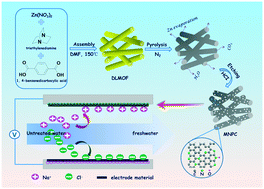Enhanced capacitive deionization of saline water using N-doped rod-like porous carbon derived from dual-ligand metal–organic frameworks†
Abstract
Capacitive deionization (CDI) removes ions from brine, and is forward-looking technology due to its low energy consumption, low cost and prevention of secondary pollution. Removal capacity is still an issue for CDI technology. It is quite urgent to design a high-performance CDI electrode material with a reasonable porous structure, excellent conductivity and hydrophilic surface. Herein, we originally designed nitrogen-doped rod-like porous carbon derived from dual-ligand metal–organic frameworks (MOFs), in which two ligands, namely 1,4-benzenedicarbocylic acid and triethylenediamine, coordinate with zinc (Zn). 1,4-Benzenedicarbocylic acid can be used as a pore-forming agent to increase the specific surface area of the carbon material, and triethylenediamine is used as a nitrogen doping source to increase the hydrophilicity and conductivity of the carbon material. By adjusting the ratio of the two ligands, the optimal specific surface area and nitrogen doping for the carbon material is obtained, thereby achieving the highest removal capacity for capacitive deionization of brine. The obtained carbon materials possess a hierarchical porous structure with moderate nitrogen doping. The large specific surface area of the electrode materials delivers many adsorption sites for adsorption of salt ions. The hierarchically porous structure provides rapid transport channels for salt ions, and high-level N doping enhances the conductivity and hydrophilicity of the carbon materials to some extent. More importantly, the salt removal capacity of the electrodes is as high as 24.17 mg g−1 at 1.2 V in 500 mg L−1 NaCl aqueous solution. Hence, the moderate nitrogen-doping porous carbon material derived from dual-ligand MOFs is a potential electrode material for CDI application. Such results provide a new method for the preparation of high-performance electrodes to remove ions from saline water.

- This article is part of the themed collection: Nanomaterial applications in water


 Please wait while we load your content...
Please wait while we load your content...